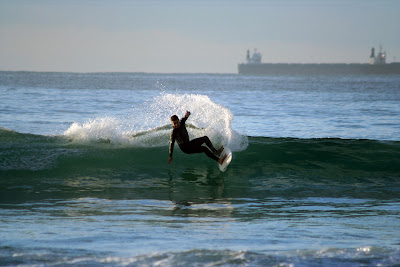Bondi Beach is about one kilometre long (≈0.6 miles) and receives many visitors throughout the year. Surf Life Saving Australia has given different hazard ratings to Bondi Beach in 2004. While the northern end has been rated a gentle 4 (with 10 as the most hazardous), the southern side is rated as a 7 due to a famous rip current known as the "Backpackers' Express" because of its proximity to the bus stop, and the unwillingness of tourists to walk the length of the beach to safer swimming. The south end of the beach is generally reserved for surfboard riding. Yellow and red flags define safe swimming areas, and visitors are advised to swim between them.
There is an underwater shark net shared, during the summer months, with other beaches along the southern part of the coast. Pods of whales and dolphins have been sighted in the bay during the months of migration. Fairy penguins, while uncommon, are sometimes also seen swimming close to shore or amongst surfers in southern line-up.
In 2007, the Guinness World Record for the largest swimsuit photo shoot was set at Bondi Beach, with 1,010 women wearing bikinis taking part.
Bondi Beach was added to the Australian National Heritage List in 2008.
Bondi Beach is the end point of the City to Surf Fun Run which is held each year in August. The race attracts over 63,000 entrants who complete the 14 km run from the central business district of Sydney to Bondi Beach. Other annual activities at Bondi Beach include Flickerfest, Australia's premier international short film festival in January, World Environment Day in June, and Sculpture By The Sea in November. In addition to many activities, the Bondi Beach Markets is open every Sunday. Many Irish and British tourists spend Christmas Day at the beach.
An Oceanway connects Bondi to South Head to the north and other beaches to the south up to Coogee.
Bondi Beach hosted the beach volleyball competition at the 2000 Summer Olympics. A temporary 10,000-seat stadium, a much smaller stadium, 2 warm-up courts, and 3 training courts were set up to host the tournament.
Lifesaving Clubs
Bondi Surf Bathers' Life Saving Club is the world's first surf lifesaving club and North Bondi Surf Lifesaving Club is a federation club. Both clubs were founded in 1907. Bondi members invented the surf reel and many other icons of lifesaving. Surf Lifesavers from both clubs were involved in the largest rescue ever on a single day, known as 'Black Sunday'. Bondi holds the most Australian Surf Lifesaving Championship gold medals in R&R (rescue & resuscitation) and North Bondi hold the most gold medals in March Past.
Bondi Icebergs
The Swimming Club's origin dates back to 1929 and owes its origins to the desire of a band of dedicated local lifesavers who wished to maintain their fitness during the winter months. They formed the Bondi Icebergs Winter Swimming Club and drew up a constitution and elected office bearers. Included in the constitution was a rule that to maintain membership it was mandatory that swimmers compete on three Sundays out of four for a period of five years.
The Icebergs became licensed in 1960 and the members moved from a tin shed into comfortable premises with Bar and Poker Machines. A further update took place in the 1970s enabling the Club to operate on two floors. In 1994, female members were admitted and in 2002 the Club opened their new premises.
Commercial area
Bondi Beach has a commercial area along Campbell Parade and adjacent side streets. Bondi Beach features many popular cafes, restaurants and hotels, with spectacular views of the beach. Hotel Bondi is a famous landmark opposite the beach featuring a number of popular bars and restaurants. The nearby Swiss Grand Hotel Bondi Beach is also a landmark development opposite the beach.
Bondi Pavilion is a community cultural centre, located right on Bondi Beach, which features a theatre, gallery, rehearsal, meeting and function rooms, art workshop, studios.. Bondi Pavilion is the centre for major festivals performances throughout the year.








0 komentar:
Posting Komentar